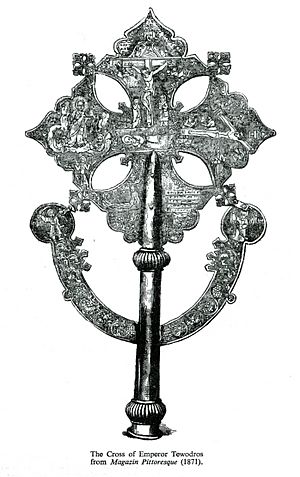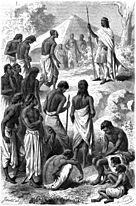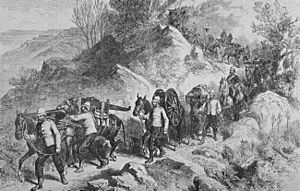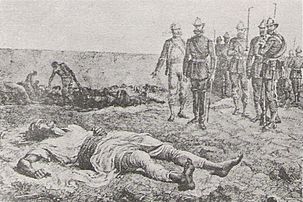Tewodros II facts for kids
Quick facts for kids Tewodros IIዳግማዊ ቴዎድሮስ |
|||||
|---|---|---|---|---|---|

Tewodros II depicted in Histoire de l'Ethiopie d'Axoum à la révolution
|
|||||
| Emperor of Ethiopia | |||||
| Reign | 11 February 1855 – 13 April 1868 | ||||
| Coronation | 11 February 1855 | ||||
| Predecessor | Sahle Dengel | ||||
| Successor | Tekle Giyorgis II | ||||
| Born | c. 1818 Qwara, Begemder Province, Ethiopian Empire |
||||
| Died | 13 April 1868 (aged 49–50) Amba Mariam, Wollo Province, Ethiopian Empire |
||||
| Burial | Medhane Alem Church, Amba Mariam (originally called Magdala) Mahbere Selassie Convent, Qwara (currently) |
||||
| Spouse | Tewabech Ali Tiruwork Wube |
||||
| Issue | Prince Alemayehu | ||||
|
|||||
| Dynasty | House of Solomon | ||||
| Father | Haile Giorgis Wolde Giorgis | ||||
| Mother | Woizero Atitegeb Wondbewossen | ||||
| Religion | Ethiopian Orthodox Tewahedo | ||||
| Styles of Tewodros II of Ethiopia |
|
|---|---|
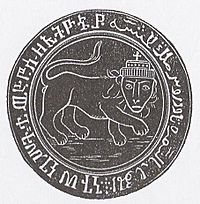 |
|
| Reference style |
|
| Spoken style |
|
| Alternative style |
|
Tewodros II (Ge'ez: ዳግማዊ ቴዎድሮስ), born Kassa around 1818, was the Emperor of Ethiopia from 1855 until his death in 1868. Many people see his rule as the start of modern Ethiopia. He ended a time called the Zemene Mesafint, or "Era of the Princes." During this era, different regions of Ethiopia were ruled by separate leaders.
Even though Tewodros II came from this time, he wanted to change things. He aimed to bring Ethiopia back together as one strong country. He also wanted to improve its government and church. He believed he was chosen by God to restore the old royal family's power.
One of Tewodros II's first goals was to control the region of Shewa. Shewa was very independent during the Era of the Princes. Its ruler even called himself "King." Tewodros brought a young prince from Shewa, Menelik II, with him. He raised Menelik like his own son. Menelik later became Emperor himself. Tewodros faced many rebellions from nobles who did not like his modern ideas.
In the first six years of his rule, Tewodros put down these rebellions. The empire was quite peaceful from 1861 to 1863. However, fighting these regional leaders took a lot of effort, money, and people. This limited what else Tewodros could do. He dreamed of a strong monarchy but faced many challenges. He wanted government officials and judges to be paid. He also created a professional standing army. This meant he did not have to rely on local lords for soldiers. He also started a library and new tax rules. He aimed for a central government with clear districts. He tried to tax church lands to help pay for the government. This made the church his enemy and did not gain him much support. Tewodros was a very skilled military leader.
Contents
Who Was Tewodros II?
Walter Plowden, a British Consul, knew a lot about Ethiopia in the 1850s. He predicted that Kassa, a warrior from Qwara Province, would become very powerful.
Early Life of Kassa Hailu
Kassa Hailu was born in Qwara, west of Gondar. His father was an Amhara nobleman named Hailegiorgis Woldegiorgis. Kassa's grandfather, Dejazmatch Woldegiorgis, was a respected figure. The area where Kassa grew up was called Ye Maru Qemas. This means "the taste of the honey." It was named after a powerful warlord and relative of Kassa, named Maru.
When Maru died, his land was given to Dejazmach Hailu. Kassa was next in line to control this land. However, Empress Menen Liben Amede took control of it herself.
Kassa's mother, Woizero Atitegeb Wondbewossen, was from a noble family in Gondar. Some stories say she sold a medicine called Kosso. However, there is no proof of this. Many writers say it was a false rumor. Evidence shows she had land and lived comfortably. Kassa's youth was not luxurious, but he was not poor.
Kassa went to school at a convent. He had to flee when it was attacked. He found safety with his relative, Dejazmach Kenfu Hailu. Kenfu was likely his uncle. Kassa continued his education and learned about the Bible and Ethiopian writings. He also learned military skills from Kenfu. After Kenfu died, Kassa had to find a new path. He offered his services to another leader, Dajazmach Goshu.
How Did Tewodros II Rise to Power?
Kassa Hailu grew up in a country filled with civil war. This time was known as the Zemene Mesafint, or "Age of the Princes." During this era, many regional leaders fought for power. They controlled the Emperor in Gondar, who was like a puppet. Regions like Gojjam and Shewa had their own royal families. In Shewa, the local prince even called himself King.
Kassa started as an shifta (outlaw). He gathered many followers. He was able to take back his father's land in Qwara. He also gained control of all of Dembiya. People liked him because he treated them well. He shared food and money with farmers. This caught the attention of Ras Ali II of Wollo, who controlled Gondar.
Empress Menen Liben Amede, Ras Ali's mother, arranged for Kassa to marry her granddaughter, Tewabech Ali. She gave him land, hoping to make him loyal.
Kassa loved his wife, but his relationship with her family got worse. Empress Menen treated him poorly. By 1852, he rebelled against Ras Ali. Over the next three years, he won many battles. These included Gur Amba, Takusa, Ayshal, and Amba Jebelli. He defeated every army sent against him. At Ayshal, he captured Empress Menen, and Ras Ali fled.
Kassa then said he was removing Emperor Yohannes III from power. He marched against his last major rival, Dejazmach Wube Haile Maryam. Kassa was crowned Emperor by Abuna Salama III on February 11, 1855. This happened in the church of Derasge Maryam. He took the name Tewodros II. He hoped to fulfill a prophecy that a man named Tewodros would make Ethiopia great again.
Tewodros II's Military Skills
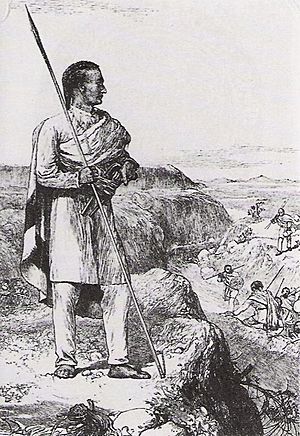
Tewodros II began his military career in his relative Kenfu Haile Giorgis's army. In 1837, he led a successful attack on Ottoman forces. He also helped defeat an Egyptian raid. When his uncle Kenfu died in 1839, Kassa lost his family's land. He became a shifta, a person who refuses to accept his feudal lord.
Kassa Hailu built his own army. When he became very powerful, he was made Dajazmach of Qwara. He was also given Tewabech, the daughter of Ras Ali, in marriage in 1845.
Kassa was very close to Tewabech. But his loyalty to Empress Menen did not last long. In October 1846, he attacked and looted Dembea. In January 1847, he took control of Gondar. Later that year, he left Gondar. Empress Menen sent an army after him. Kassa easily defeated the army and captured the Empress. Her son, Ras Ali, made a deal with Kassa. Kassa released his mother, and in return, he received all lands west and north of Lake Tana.
In 1842, Tewodros invaded Egyptian-controlled Sudan. He captured Metemma. However, he lost a major battle in March 1848. This defeat ended his invasion. After this loss, Tewodros worked to modernize his army. He taught them how to use firearms and modern artillery.
What Did Tewodros II Do as Emperor?
Tewodros wanted to unite and modernize Ethiopia. But he was often away fighting. Disloyal leaders often tried to rebel when he was gone. Within a few years, he brought Shewa and Gojjam back under his direct rule. He defeated many lords in Wollo and Tigray. He also brought Begemder and Simien under his control.
He moved the capital city from Gondar to Debre Tabor, and then to Magdala. Tewodros ended the time when Ethiopia was divided among many regional lords. He brought regions like Gojjam, Tigre, Shewa, and Wollo back under the Emperor's direct control. He imprisoned his rivals and their families at Magdala. Among them was young Prince Sahle Mariam of Shewa, who would become Emperor Menelik II. Tewodros liked the young prince and married him to his own daughter, Alitash Tewodros. Menelik later escaped from Magdala and left his wife, which upset Tewodros greatly.
The death of his beloved wife, Empress Tewabech, changed Tewodros II. He became more unpredictable and vengeful. For example, after his friend John Bell was killed, Tewodros had 500 prisoners beheaded. In February 1863, after defeating a rebel, Tewodros ordered 7,000 prisoners killed.
Tewodros II married again. His new wife was Empress Tiruwork Wube, the daughter of his imprisoned enemy, Dejazmach Wube. Tiruwork was a proud woman from a noble family. She had wanted to become a nun. Her family convinced her to marry the Emperor, hoping it would free her father and brothers. But Tewodros did not release them. This made Empress Tiruwork very bitter towards him. Their marriage was not happy. They had a son, Dejazmatch Alemayehu Tewodros, whom the Emperor loved and saw as his heir.
By October 1862, Emperor Tewodros's power was shaky. Much of Ethiopia was rebelling against him. He was constantly fighting many different rebels. Ethiopia was also threatened by Muslim groups from the Red Sea and Sudan. Tewodros wrote a letter to Queen Victoria of Britain. He asked for British help as a fellow Christian ruler. He asked the British Consul, Captain Charles Duncan Cameron, to take the letter. He wanted skilled workers to come and teach his people how to make firearms.
Cameron sent the letter to London instead of taking it himself. He was told to go to Sudan to check on the slave trade. When Cameron returned to Ethiopia, Tewodros was furious. He found out Cameron had not delivered the letter personally. He also learned Cameron had traveled through enemy lands. Cameron tried to calm him, saying a reply would come soon. But the British Foreign Office did not give the letter to Queen Victoria. They just filed it away.
Britain had reasons for ignoring the letter. The British Empire wanted to work with the Ottoman Empire, Egypt, and Sudan. This was to protect their route to India. They also wanted to keep the Ottoman Empire as a buffer against Russia. Also, the American Civil War stopped cotton from the US. Britain needed cotton from Egypt and Sudan. They did not want conflict in the region.
After two years, Tewodros still had no reply. He imprisoned Cameron and all other British and European people in Ethiopia. He hoped this would get the Queen's attention. Among his prisoners was a missionary named Henry Aaron Stern. Stern had written a book calling Tewodros cruel. When Tewodros saw this book, he became very angry. He almost shot Stern and had to be held back. He then beat Stern's two servants to death. Tewodros also heard that foreign newspapers quoted these Europeans saying bad things about him.
Conflict with Great Britain
The British sent a mission led by Hormuzd Rassam. He brought a letter from the Queen, but not the skilled workers Tewodros had asked for. Tewodros felt insulted. He added Rassam's group to his other European prisoners. This act led Britain to launch the British Expedition to Abyssinia in 1868. It was led by Robert Napier. He came from India with over 30,000 people. This included soldiers and engineers.
Tewodros had become very unpopular because of his harsh rule. Many regional leaders had rebelled against him. Several of them helped the British. They provided guides and food as the British marched towards Magdala. This was Tewodros's mountain fortress.
The British army defeated the Ethiopian army at Arogye on April 10, 1868. Tewodros's army was badly beaten. Many of his soldiers left him. He was left with only 4,000 soldiers. Tewodros II tried to make peace. Napier said he would treat the Emperor and his family with respect. Tewodros II angrily replied that he would never be captured. The British then shelled Magdala. This killed most of Tewodros's remaining soldiers. Tewodros released all the Europeans unharmed. But he ordered 300 Ethiopian prisoners to be thrown off a cliff.
Tewodros chose to die rather than be captured. This made him a symbol of Ethiopian independence. He used a dueling pistol given to him by Queen Victoria. British troops buried Tewodros II at Magdala's Medhane Alem Orthodox Church. In 2019, the National Army Museum returned a lock of Tewodros's hair to Ethiopia.
Magdala was in the territory of the Muslim Oromo people tribes. Tewodros had taken it back from them earlier. Two rival Oromo queens had helped the British. They both claimed control of the fortress as a reward. Napier wanted to give Magdala to the Christian ruler of Lasta, Wagshum Gobeze. But Gobeze was not interested. Since the Oromo queens could not agree, Napier decided to destroy the fortress.
After Tewodros was buried, Napier allowed his troops to loot the citadel. Fifteen elephants and almost 200 mules were needed to carry away the treasures. These items are now in museums and collections across Europe. Some have been returned to Ethiopia. Tewodros II's family later moved his remains to the Mahedere Selassie Monastery in Qwara. They are still there today.
Tewodros had asked his wife, Empress Tiruwork Wube, to put their son, Prince Alemayehu, under British protection if he died. He feared that any new ruler would kill his son. So, Alemayehu was taken to London. Queen Victoria liked the young boy. Alemayehu studied at schools in England. However, he became lonely and sad. In 1879, he died at age 19. He was buried near the royal chapel in Windsor. Queen Victoria placed a plaque in his memory.
Some of the European hostages were unhappy about leaving Ethiopia. They felt they had become used to their new home. Many of them later returned to Ethiopia.
After Tewodros's death, there were some short fights for the throne. Eventually, Yohannes IV became the next Emperor of Ethiopia.
Tewodros II's Children
Empress Tiruwork and young Prince Alemayehu were to be taken to England. However, Empress Tiruwork died on the way to the coast. Little Alemayehu traveled alone. The Empress was buried at Sheleqot monastery. Queen Victoria paid for Alemayehu's education. Captain Tristam Speedy became his guardian. Alemayehu grew very close to Captain Speedy and his wife. But he became lonely and his health was poor. He died in October 1879 at age 19. He never saw his homeland again. Queen Victoria wrote in her journal about his death: "It is too sad! All alone in a strange country, without a single person or relative belonging to him... His was no happy life."
Emperor Tewodros II had an older son born outside of marriage, named Meshesha Tewodros. Meshesha often disagreed with his father. He even helped Menelik of Shewa escape from Magdala. When Menelik became Emperor, Meshesha Tewodros was given the title of Ras. He was also given Dembia as his land. Ras Meshesha remained a loyal friend to Emperor Menelik II until his death. His descendants were seen as important nobles.
Tewodros II's daughter, Woizero Alitash Tewodros, was the first wife of Menelik of Shewa. Menelik later became Emperor Menelik II. Woizero Alitash was left behind when Menelik escaped from Magdala. She later married Dejazmatch Bariaw Paulos. When Menelik II became Emperor, Alitash was one of the first nobles to pay him respect. Some rumors say that Alitash and Emperor Menelik might have gotten back together. There are also rumors that Alitash became pregnant. Some stories say that Empress Taytu Bitul, who had no children, had Alitash poisoned. Other rumors say Alitash gave birth to a boy. She supposedly gave him to a friend to be raised as a farmer. Regardless of these stories, Woizero Alitash Tewodros died within the first few months of her ex-husband Menelik II's rule.
Honours
 Ascanian duchies: Grand Cross of Albert the Bear, 15 March 1863
Ascanian duchies: Grand Cross of Albert the Bear, 15 March 1863
Images for kids
See also
 In Spanish: Teodoro II de Etiopía para niños
In Spanish: Teodoro II de Etiopía para niños





